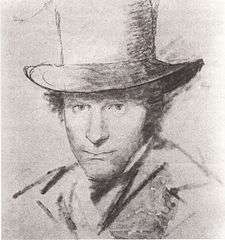Carl Blechen

Carl Eduard Ferdinand Blechen (29 July 1798, Cottbus - 23 July 1840, Berlin) was a German landscape painter and a Professor at the Academy of Arts, Berlin.[1] His distinctive style was characteristic of the Romantic ideals of natural beauty.
Life

His father was a minor tax official from Regensburg. From 1805 to 1815 he attended the Lyceum at the Oberkirche St.Nikolai in Cottbus. His parents could not afford to pay for any further education, so they apprenticed him to a banker and he was engaged in that profession until 1822, when an increasing interest in art led him to the Berlin Academy.[1]
After a short study trip to Dresden and Saxon Switzerland, he returned to Berlin and obtained a position as a decorator for the Royal Theater on the Alexanderplatz. He married in 1824 and became a member of the Berlin Artists' Association in 1827. Later that year, he was dismissed from the Theater because of an ongoing dispute with singer Henriette Sontag. After that, he tried to support himself as a free-lance artist. In 1828, he took a study trip to the Baltic Sea, followed by a trip to Italy which produced hundreds of sketches that were later elaborated in his Berlin studio. He had been deeply impressed by the landscapes there and altered his entire manner of painting to reflect what he had seen.[1]
Final years and illness
In 1831, upon the recommendation of Karl Friedrich Schinkel, he was appointed Professor of Landscape Painting at the Berlin Academy. In 1835 he became a full member of the Academy and took a study trip to Paris. It was then that the first symptoms of his mental illness appeared.[1]
His condition deteriorated and he suffered severe bouts of depression that forced him to take a leave of absence from the Academy in 1836. The following year, he had to be admitted to a hospital. He was able to make one final trip to Dresden, where he made his last drawings. He died four years later, in a state of total mental derangement. He was buried in the Holy Trinity Cemetery (II), but the exact location is no longer known. He is commemorated with a plaque on the cemetery wall.
A street and an elementary school in Cottbus were named after him. In 2008, the school building became part of the "Blechen-Carré", a major shopping center.[2] Most of his works are in private collections. He was one of the first European painters to represent early industrialization as part of his landscapes.[3]
Gallery
 Im Berliner Tiergarten, 1825
Im Berliner Tiergarten, 1825 Waldweg bei Spandau
Waldweg bei Spandau- Bau der Teufelsbrücke, 1830–32
.jpg) View of Assisi 1832-35
View of Assisi 1832-35 Bathers in the Park of Terni (Badende im Park von Terni), 1836
Bathers in the Park of Terni (Badende im Park von Terni), 1836 Gorge near Amalfi (Schlucht bei Amalfi), 1831
Gorge near Amalfi (Schlucht bei Amalfi), 1831 Im Park der Villa d'Este, 1830
Im Park der Villa d'Este, 1830 The Interior of the Palm House, 1832-1834
The Interior of the Palm House, 1832-1834
References
- 1 2 3 4 Paul Ortwin Rave (1955), "Blechen, Karl", Neue Deutsche Biographie (NDB) (in German), 2, Berlin: Duncker & Humblot, pp. 295–295; (full text online)
- ↑ Blechen-Carré website
- ↑ Berger, Karl. Karl Blechen, Leipzig: E.A. Seemann Verlag, 1965. Hilger, Hans-Peter. "Anfänge der Industriemalerei in Deutschland" Der Anschnitt. Vol 12 S. 10-14, 1960. Vignau-Wilberg, Peter. "Das ‚Walzwerk in Eberswalde’ von Carl Blechen und die frühe Industriedarstellung,"in Carl Blechen (1798 - 1840): Grenzerfahrungen - Grenzüberschreitungen, Vogel, Gerd-Helge and Barbara Baumüller, eds.. Greifswald: Steinbecker Verlag, 2000.
Further reading
- Robert Dohme (1875), "Blechen, Karl Eduard Ferdinand", Allgemeine Deutsche Biographie (ADB) (in German), 2, Leipzig: Duncker & Humblot, pp. 700–701
- Irma Emmrich, Carl Blechen, Verlag der Kunst, Dresden (1989)
- Carl Blechen. Zwischen Romantik und Realismus, Exhibition Catalog from the Berliner Nationalgalerie, Prestel Verlag, Munich (1989)
- Carl Blechen. Bilder aus Italien, Bezirksmuseum Cottbus, Schloss Branitz, Cottbus (1990)
- Beate Schneider, Carl Blechen, Niederlausitzer Landesmuseum Cottbus, E. A. Seemann, Leipzig (1993)
- Heino R. Möller, Carl Blechen, from Romantische Malerei und Ironie, Alfter (1995)
- Barbara Baumüller, Gerd-Helge Vogel (eds.), Carl Blechen (1798-1840). Grenzerfahrungen - Grenzüberschreitungen, Greifswalder Romantikkonferenz, Steinbecker Verlag Rose, Greifswald (2000) ISBN 978-3-931483-24-1
- Beate Schneider, Reinhard Wegner(eds.), Die neue Wirklichkeit der Bilder. Carl Blechen im Spannungsfeld der Forschung, Lukas, Berlin (2008) ISBN 978-3-86732-044-3
- O'Neill, J (ed.). German masters of the nineteenth century : paintings and drawings from the Federal Republic of Germany. New York: The Metropolitan Museum of Art. (1981)
External links
| Wikimedia Commons has media related to Carl Blechen. |
- Carl Blechen Gesellschaft e.V. Cottbus (German)
- Werke von Carl Blechen @ Digitales Belvedere
- Literature by and about Carl Blechen in the German National Library catalogue
- "Works by Carl Blechen". Zeno.org (in German).